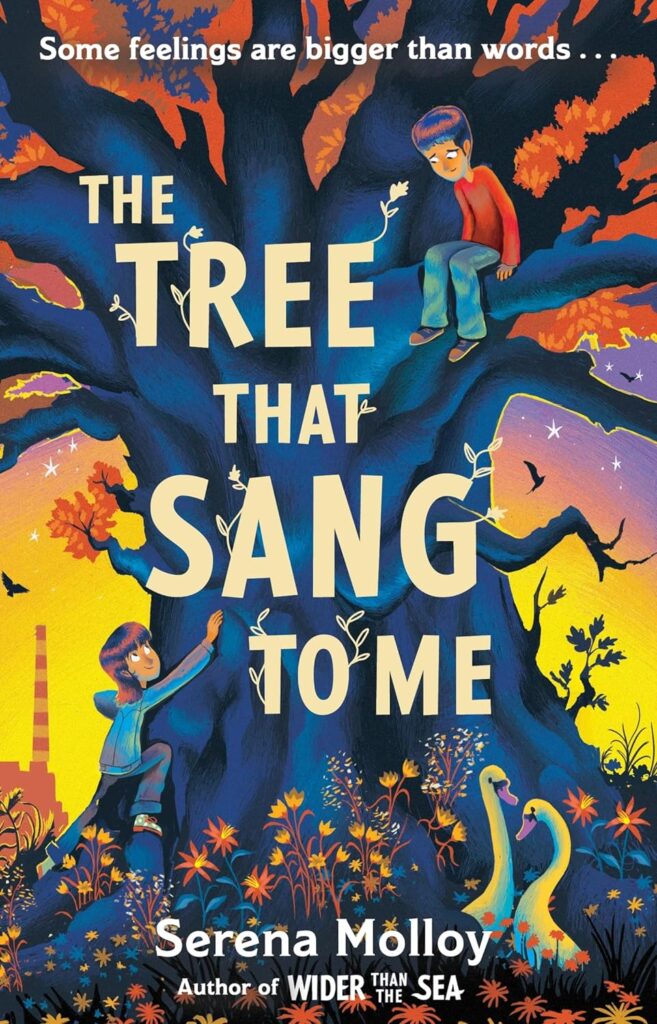I’m a HUGE fan of WIDER THAN THE SEA, so when the chance came to interview Serena Molloy about her beautiful new book THE TREE THAT SANG TO ME, I jumped at it!
Before we settle down in The Reading Realm to talk about your new book, what’s your drink and snack of choice?
Tea! Nothing beats a good cup of tea, strong enough to trot mice on, as my granny used to say. I try to stick to fruit for a snack, my current favourite is cherries.

Without giving too much away, what can you tell us about The Tree That Sang To Me?
It is the story of 11 year old Dublin boy, Kai and his relationship with his big sister, Jen. Kai is an anxious child who struggles to express his feelings but Jen is always there for him. They have a super-close bond until one day she leaves the family home and he feels totally alone. He finds comfort in climbing a sycamore tree that grows on some wasteland near his house. One day, he notices someone else has been visiting his tree and a new and unlikely friendship develops, one that helps him to deal with his feelings of loss . . .
How is this book different to your debut book Wider Than the Sea? How is it similar?
It is similar in that it is illustrated throughout by the amazingly talented George Ermos and is written in verse with dyslexic friendly font. I wanted my books to be as accessible as possible to all readers. As a dyslexic person, this is something that is very important to me. I was lucky to have a publisher (Hachette Children’s) who was fully onboard with this. They have also produced audio books for both books so that even more children can access them. It is different in that Wider Than The Sea actually features a main character, Ró, who is dyslexic, where as Kai has other challenges to face, at home and at school and within his own head.

What is it about writing in verse that appeals to you?
That’s a great question. I think what appeals to me most is that you can distil each scene down to the key elements, cutting out all the supporting prose, so what you are left with is more powerful, more impactful. I also love the crafting process, every single word has to justify its place on the page, if it isn’t earning its keep, it goes. I love playing with the words, the sounds and even the spaces, in verse they have meaning too. I also love making each verse a complete piece of work in its own right, something that is a finished piece in and of itself. Poems and rhymes are among the first pieces of literature we encounter as small children, giving comfort, stability and reassurance. I always want my writing to do that. As an Irish writer I think poetry is deep in our souls, it is part of who we are.
Can you remember the first time you saw the beautiful front cover by George Ermos? What was it like?
Yes! George is just amazing. He has done both my covers and the internal illustrations too. When I saw the cover of The Tree That Sang to Me I was a ball of mush. Honestly, it was like he had seen into my head and drawn what was written there. I love the way he has included the Poolbeg chimneys in the image, a familial symbol to all Dubliners.
What do you hope young readers will take away from The Tree That Sang To Me?
Hope. Hope. Hope. I always want readers to go away feeling there is a little more hope in the world after reading my books, that even though there will always be dark moments they too will pass. That hope can be found in the most unexpected places and people. Kai finds hope in nature, in his tree and he finds hope in his new friend Sky, once he is brave enough to let her in.
If The Tree That Sang To Me was a song, what song would it be and why?
Better Days by Dermot Kennedy. His music is very special with such careful lyrics. In the story, you want to tell Kai to hold on in there when things get tough, even when he’s hurting. By the end of the story Kai knows that indeed ‘better days are coming’ for him.
Finally, can you describe The Tree That Sang To Me in three words?
Vulnerability. Love. Hope.

